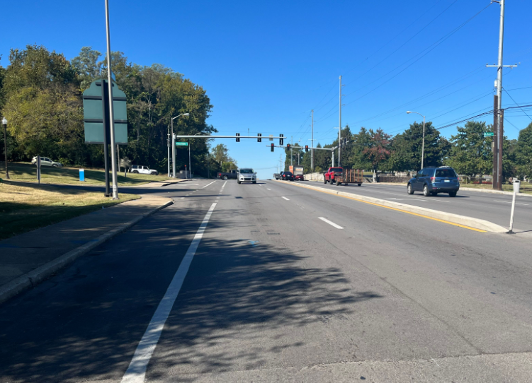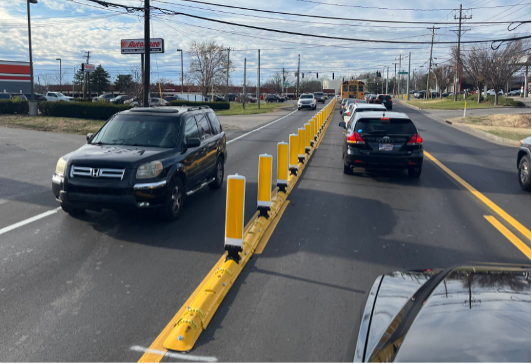Search for articles or browse our knowledge portal by topic.
Access Management for Existing Conditions
Once a highway is built, access modifications for new or existing entrances must be approved by KYTC through the encroachment permit process. KRS 177.106 provides the statutory authority for the Cabinet to approve or deny encroachment requests, and to remove unapproved encroachments if the responsible party fails to remove or relocate the encroachment within seven days. The Division of Maintenance Permits Guidance Manual, as revised and effective September 17, 2021, outlines methods used by the Cabinet to evaluate encroachments.
Type of access control dictates how KYTC reviews requests for new or modified entrances. 603 KAR 5:120(1) defines three types of access control:
Access by Permit highways are those designated as access by permit on Department of Highways plans. Highways without documented plans are typically assumed to be access by permit. When a request to modify access on Access by Permit highways is submitted, it is reviewed at the District level to verify the proposed location has the necessary intersection sight distance and meets all other requirements listed in the Permits Guidance Manual.
If relocating an existing entrance constitutes an improvement (according to standard engineering practices and based on safety criteria), KYTC may grant the request even if the new entrance’s sight distance is inadequate.
Partially-controlled access highways give preference to through traffic but may allow access to select public roads and streets. Some highway at-grade intersections and private driveway connections may be allowed as shown on Department of Highways plans. Upon request from an property owner or local government, access points may be added or relocated if spacing from other entrances meets minimum requirements outlined in KRS 177.315(2) — 1,200 feet in rural areas and 600 feet in urban areas. Exceptions to this spacing may be allowed if supported by an engineering and traffic study approved by the State Highway Engineer.
When KYTC approves access modifications on a partially-controlled highway, the property owner must compensate the Department of Highways for any increase in the affected property’s value that is attributable to the new access, based on before-and-after appraisals (603 KAR 5:120(4)(6)). This requirement provides a mechanism to reimburse the Road Fund for additional costs incurred during the right-of-way acquisition phase, which establishes existing access or lack thereof.
Fully-controlled access highways give preference to through traffic and provide access only at select public roads or streets. They have no at-grade crossings or intersections. Examples include interstates and most of Kentucky’s parkway routes, but other highways may receive this designation. Modifying access to a fully-controlled access highway is rare since it typically requires constructing a new grade-separated interchange. Access changes on interstates must also be approved by FHWA.
KAR 603:5:120(5) outlines procedures for changing access control on existing highways. It allows reducing access restrictions may be reduced when:
- Doing so will not significantly impair highway safety, and
- The existing roadway has either been replaced by a parallel route or the entire corridor has been constructed and potential land use developments have been accomplished.
More restrictive access control may be established to meet highway safety requirements and traffic control needs.
The State Highway Engineer determines if requirements have been met based on the recommendations of the Directors of the Divisions of Maintenance, Traffic Operations, Construction, Right-of-Way & Utilities, and Highway Design, in addition to the FHWA when applicable. The Commissioner of Highways has the final authority to change access control.
In situations where KYTC imposes more restrictive access control, the Department of Highways must provide reasonable access or compensate property owner(s) for loss of reasonable access.
Often, KYTC permit and maintenance engineers encounter access control issues they cannot address easily within existing policy guidelines. This may happen when commercial or private development occurs without proper consideration being given to vehicle access or when unexpected changes to traffic patterns result in additional access needs.
The developer or property owner is responsible for obtaining a proper encroachment permit approval prior to construction to ensure they can obtain access. When permit requests are made before construction, KYTC can help provide safer access that better aligns with internal traffic circulation and is less disruptive to mainline traffic.
KYTC is not obligated to provide access in situations where insufficient sight distance or spacing limitations will compromise safety. However, Cabinet staff should try to identify acceptable solutions that meet policy guidance. This can sometimes be done by moving the location of an entrance or reducing the number of entrances.
When no solution consistent with agency policy can be identified, the request must be denied by the district. If the applicant subsequently files a request for reconsideration as outlined in the Permits Manual, the district shall refer the request to the Central Office Permits Branch in the Division of Maintenance. The Director of Maintenance — with input from the Permits Branch Manager, District Permits staff, and the Chief District Engineer — then submits a recommendation to the State Highway Engineer, who makes a final determination.
The State Highway Engineer is authorized to override KYTC encroachment policies and may choose to do so after evaluating the circumstances surrounding a given situation. While engineering staff should not deviate from policy in anticipation of such a decision, they may need to provide the State Highway Engineer with alternatives that do not meet policy standards, but which mitigate the potential negative impacts of a non-conforming entrance. Providing these alternatives lets the Cabinet achieve the best possible outcome, one that balances technical issues and other factors that warrant consideration.
In situations where KYTC standards cannot be fully met, a common compromise is to install a right-in/right-out (RI/RO) entrance instead of a full-access entrance. RI/RO entrances only allow traffic to enter or exit a property by making a right turn. Left-turning vehicles must use a different entrance or execute a legal U-turn maneuver at an adjacent intersection to use the RI/RO entrance.
While property owners typically prefer unrestricted access for vehicles turning either left or right, RI/RO entrances can improve the safety and mobility of traffic on the main road while still providing adequate access to adjacent property. Eliminating left-turning vehicles reduces the number of conflict points where crashes may occur and reduces backups from vehicles on the mainline waiting for left-turn opportunities.
In addition to mitigating the negative consequences of requests for new entrances that do not conform to KYTC standards, left-turn restrictions can also be used in locations where an existing full-access entrance presents safety and mobility issues for mainline traffic. These issues can occur anywhere, but they are more frequent near signalized intersections where mainline traffic queues limit turning opportunities and obscure vehicles attempting to make left turns. The best way to approach modifying access at existing entrances is to engage in open, respectful dialogue with affected property owners to communicate the existing problem and to mitigate any concerns they have. District engineers should develop relationships with Planning and Zoning Commissions and other local officials who can help to resolve these issues in a way that is consistent with KYTC policy and regulations.
Signage alone is insufficient to restrict left turns. Typically, physical barriers must be installed to deter vehicles from attempting left turns. Options include medians, curbs, or flexible delineators placed along the main road’s centerline, at the entrance, or a combination of both (Table 1). Several factors influence what type of barrier should be used:
- Roadway characteristics (particularly roadway width and lane width)
- Funding available to complete the work
- Urgency of the need
The most effective solutions establish a positive barrier such as a depressed median or barrier wall, but their installation can be very expensive and require significant effort. Usually, these solutions are reserved for larger construction projects.
| Table 1 Summary of Common Installation Options for Restricting Left Turns at Entrances | ||||
|---|---|---|---|---|
| Installation Type | Expense | Right-of-Way Requirements | Installation Effort | Effectiveness |
| Depressed Median | High | High | High | High |
| Barrier Wall | High | Medium | High | High |
| Raised Median | Medium | Medium | Medium | Medium |
| Centerline Curb | Low | Low | Medium | Medium |
| Raised Lane Separator | Low | Low | Low | Medium |
A non-mountable raised median is a less expensive option that deters most drivers from attempting a left turn (Figure 1). In this example, a flared traffic island at the entrance provides additional benefit by guiding vehicles into a right-turn from the entrance. If problems were to continue with vehicles traversing the raised median, flexible delineators or panels could be installed to discourage these movements.

Figure 1 Curbed median along the mainline with an island at the entrance to restrict left turns.
While less complicated than installing a depressed median or other positive barrier, constructing a raised median still requires a significant amount of right of way, design work, and funding. If a raised median is installed as part of an encroachment permit to provide access to a development, the property owner may be required to pay for some or all the expense. In cases where Road Fund dollars will be used, KYTC may attempt to fund the project through the Enacted Highway Plan, discretionary funding, or other construction funding.
Where space does not allow for installation of a wide median, a narrow curb may be installed along the roadway centerline (Figure 2).

Figure 2 Concrete curb located along the centerline of mainline roadway
Here, the existing sidewalk, signage, and roadway lighting made it difficult to install a flared traffic island without significant expense. A simple curb along the roadway’s centerline was built to deter left turns into and out of the entrance. An installation like this one may require restriping the roadway to provide sufficient width for the curb at the centerline. Incorporating this work into a pavement resurfacing project would reduce the costs associated with restriping and ensure a more aesthetically pleasing final product. While FD05 resurfacing funds would not typically be used to pay for the curb itself, in some cases it may make sense to do so where other concrete work is already required elsewhere on the project. If the work is not included in another construction project, KYTC may use a master agreement or install the curb with state forces where qualified personnel and resources are available.
One of the quickest and least expensive options for restricting left turns is the installation of a raised lane separator with panels (Figure 3). Several manufacturers make these devices, and they are often called by their brand names (e.g., Qwik Kurb, Dura-Curb, Tuff Curb). KYTC maintains a master agreement for lane separators, and state forces can perform installations as well. Lane separators are a good solution where narrow roadway widths prevent the use of other devices. They also are relatively simple to remove for pavement repairs.

Figure 3 Raised lane separator (Qwick Kurb) with panels
When installing a curb or raised median on an existing roadway that was not originally designed for such a device, engineering staff should consider how water will interact with the barrier. Cutting drainage channels into the device may be necessary to prevent water from ponding on the roadway.
Property owners or developers are responsible for funding the construction of new private entrances. However, when appropriate KYTC may choose to incorporate and fund other improvements in conjunction with a new private entrance. If the Cabinet initiates a project to improve safety or mobility at existing entrances, the agency generally covers the entire project cost. Payment for these improvements typically comes from Enacted Highway Plan funding, discretionary funding, or other construction funding. In rare cases, these projects may be eligible for Highway Safety Improvement Program (HSIP) funding if (1) the location and proposed project meet the program’s requirements and (2) the Central Office HSIP branch approves.

